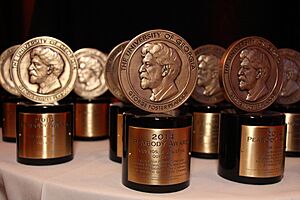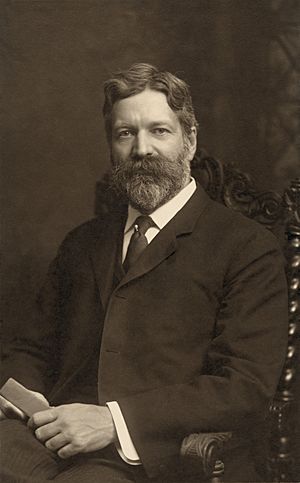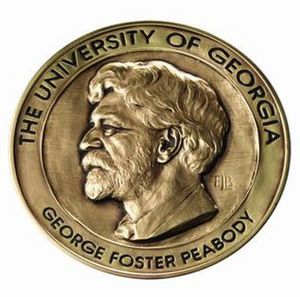Peabody Awards facts for kids
Quick facts for kids Peabody Awards |
|
|---|---|

2014 statuettes
|
|
| Presented by | Henry W. Grady College of Journalism and Mass Communication at the University of Georgia |
| Country | United States |
| First awarded | March 29, 1941 |
The Peabody Awards are very special prizes given to the best and most important stories told through television, radio, and online media. They are named after a kind businessman named George Foster Peabody. These awards are highly respected in the media world because they are connected to a university and are known for choosing truly excellent work.
The Peabody Awards are the oldest major awards for electronic media in the United States. They started in 1940 to celebrate great radio shows, like the Pulitzer Prizes do for journalism. Later, they began to include television, and then new media like podcasts and streaming. A special group of judges chooses the winners. They look for "Excellence On Its Own Terms," meaning they pick programs based on how good the storytelling is, not just how popular or commercially successful they are.
Programs can win in eight different areas: Entertainment, Documentary, Arts, Children's/Youth, News, Podcast/Radio, Interactive & Immersive, and Public Service. Winners can be radio and television stations, networks, online media, production companies, and even individuals from all over the world.
Contents
How the Peabody Awards Started
In 1938, a group called the National Association of Broadcasters wanted to recognize amazing achievements in radio broadcasting. A person named Lambdin Kay, who worked for WSB radio in Atlanta, is given credit for coming up with the idea for the award. He named it after George Foster Peabody, who gave money to make the awards possible.
Lambdin Kay met John E. Drewry from the University of Georgia's Henry W. Grady College of Journalism and Mass Communication. Drewry liked the idea, and so the Peabody Award was officially created in 1940. The University of Georgia's Grady College became its permanent home.
At first, the Peabody Awards were only for radio shows. But in 1948, they started giving awards for television programs too. In the late 1990s, new categories were added for content found on the World Wide Web. However, movies made only for cinemas cannot win a Peabody Award.
How Peabody Winners Are Chosen
The way Peabody Awards are judged changed in 2014. Before that, many entries were reviewed by about 30 committees. These committees included teachers, staff, and students from the University of Georgia and other universities. They would watch or listen to entries and then recommend them to the main Peabody Board of Jurors.
Since 2015, the first round of judging is done by teachers at major research universities across the United States. The main Board of Jurors has 18 members, who are experts like scholars, critics, and media professionals. This board selects the nominees and the final winners each year. They meet several times to discuss the recommended entries and their own choices.
The Board meets at the University of Georgia in early April for final viewings and discussions. Each entry is judged on its own quality. Only programs that are chosen by everyone on the board receive a Peabody Award. For many years, there was no set number of awards given. However, since 2016, they usually pick 30 winners, which are considered the very best out of 60 nominated programs.
Important People Behind the Awards

- George Foster Peabody (1852–1938) was a very successful banker. He used a lot of his money to support education and help society. The awards are named after him.
- Lambdin Kay was the person who first suggested creating an award to honor the best radio programs and performances in the country.
- John E. Drewry (1902–1983) was the first dean of the Henry W. Grady College of Journalism and Mass Communication at the University of Georgia. He helped Lambdin Kay create the Peabody Awards in 1940.
- Worth McDougald (1926–2007) was the director of the Peabody Awards program from 1963 until he retired in 1991.
- Barry Sherman (1952–2000) directed the Peabody Awards program from 1991 until he passed away in 2000.
- Horace Newcomb held a special teaching position for the Peabodys at the University of Georgia from 2001 to 2013.
- Jeffrey P. Jones took over from Horace Newcomb in July 2013. He now holds the special teaching position for the Peabodys at the University of Georgia.
Award Announcements and Ceremonies
Every spring, the Peabody Awards Board of Jurors announces the winners for work released in the previous year. Usually, the winners are announced through a simple press release or a press conference. For example, in April 2014, the winners for 2013 were announced on CBS This Morning. In April 2015, the 2014 Peabody winners were revealed over eight days, with entertainment winners announced on ABC's Good Morning America.
The official Peabody Awards ceremony usually happens in late May or early June. For many years, the awards were given out during a lunch in New York City. However, on May 31, 2015, the ceremony became a fancy evening event with a red carpet for the first time. Fred Armisen was the host that year. Many famous people have hosted the Peabody Awards ceremonies over the years, including Walter Cronkite, Jon Stewart, and Larry King. From 2014 to 2016, the Peabody Awards ceremony was shown on the TV channel Pivot a little later. On June 2, 2017, a TV special about the 76th Peabody Awards was shown on PBS and Fusion.
Peabody Awards Collection and Archives
The Peabody Awards Collection is a very important part of The Walter J. Brown Media Archives & Peabody Awards Collection. These archives are kept at the Richard B. Russell Building Special Collections Libraries on the campus of The University of Georgia. The main goal of the Peabody Archive is to save, protect, and make available old videos and sound recordings. These recordings show the history of broadcasting and the state of Georgia.
The collection has almost every entry submitted for this major broadcast award in the United States. Entries started in 1940 for radio and 1948 for television. At least 1,000 new entries are added every year. These programs are made by local, national, and international producers. The collection offers a look at television from its very beginning until today. It includes news, documentaries, entertainment, educational shows, and children's programs. After judging is finished, all entries are moved to the Main Library for detailed cataloging, access, and long-term preservation.
In 2017, the Walter J. Brown Media Archives & Peabody Awards Collection at the University of Georgia and WGBH received a grant. This grant helped them to digitize, save, and make available about 4,000 hours of public broadcasting programs. These programs were nominated for a George Foster Peabody Award between 1941 and 1999. The full collection will eventually have 4,000 digitized hours of audio and video recordings from 230 public broadcasting stations across 46 states, Puerto Rico, and the District of Columbia.
See also
 In Spanish: Premios Peabody para niños
In Spanish: Premios Peabody para niños
- List of American television awards
- List of Peabody Award winners (1940–1949)
- List of Peabody Award winners (1950–1959)
- List of Peabody Award winners (1960–1969)
- List of Peabody Award winners (1970–1979)
- List of Peabody Award winners (1980–1989)
- List of Peabody Award winners (1990–1999)
- List of Peabody Award winners (2000–2009)
- List of Peabody Award winners (2010–2019)
- List of Peabody Award winners (2020–2029)


